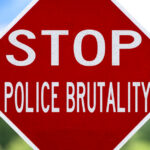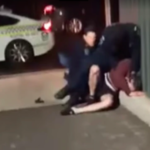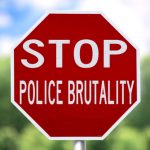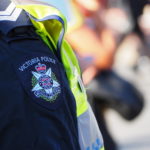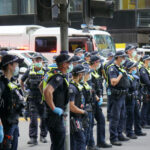NSW Police Watchdog Recommends Assault Charges for Brutality Against Teen
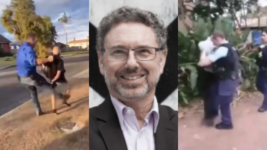
Hospital staff witnessed a 17-year-old First Nations boy waiting for treatment, whilst in the custody of two NSW police officers in late 2020, make a run for it, and the aggressive response of one officer so disgusted them that they reported the incident to the Law Enforcement Conduct Commission.
The “slightly built Aboriginal boy” was chased and tackled to the ground by the officer, who, while “on top of him, with his left arm around” his neck, punched the teen in the face three times, and after handcuffing him, dragged the boy by the cuffs more than five metres back to his seat.
Released early last week, the LECC report into the incident found the offending officer had engaged in “serious misconduct” and recommended the NSW Director of Public Prosecutions consider charging him with two counts of common assault for the “excessive and unlawful use of force”.
But this example of police brutality directed towards a First Nations teen is hardly the first. A cop was caught on camera beating on an 18-year-old disabled Aboriginal man just weeks ago. And while these cases come up periodically, we don’t hear about the same in regard to non-Indigenous teens.
So, the obvious question is if the entire NSW constituency is regularly updated about these cases of adult law enforcement officers beating on Indigenous kids, why doesn’t the management of the NSW Police Force put a stop to it, rather than, as it appears, simply sweeping it under the carpet.
Use of force probe warranted
“This is a disgraceful case of police violence against a young Aboriginal boy who was receiving care in hospital,” National Justice Project director George Newhouse told Sydney Criminal Lawyers.
“It is hard to believe that an officer twice the boy’s weight would punch a child violently multiple times and then drag him by the handcuffs for assistance of 6 to 7 metres,” the lawyer added. “The circumstances of this case vindicate the ongoing demands for an inquiry into police use of force.”
NSW police excessive use of force has been front and centre again since May, as officers have killed four civilians they were called upon to police as they were having a mental health episode. And a NSW parliamentary mental health inquiry is currently considering alternatives to policing such crises.
However, NSW Greens MLC Sue Higginson has been calling for a broader inquiry into the NSW police use of force, whilst Newhouse and the NJP have recently suggested a Royal Commission that would tackle these issues nationwide might be warranted after the fourth police killing two weeks ago.
“We will continue to see police brutality, injuries and more deaths until there is independent oversight of police by affected groups,” Newhouse underscored. “It should not be a case of police investigating police.”
Authorised violence
When questioned why police brutality simply continues to occur in plain sight of the entire community, Newhouse advises that there’s “a cultural problem in policing”, as “the structure of the police force is a hierarchical, command-and-control structure along military lines”.
“Officers are authorised to use violence and weapons against individuals without meaningful accountability,” the lawyer continued. “There are virtually no consequences when a police officer uses force against any individual, particularly when that individual comes from a vulnerable group.”
And Newhouse knows this all too well. The National Justice Project specialises in representing First Nations peoples, people with disabilities and other marginalised groups, who’ve been subjected to state violence spurred by the racism and discrimination that pervades Australian policing systems.
The sole NSW police watchdog, the LECC commenced operations in mid-2017, in an effort to streamline oversight, which had previously involved several bodies. And the poorly resourced LECC only monitors police critical incidents investigations, whilst it conducts misconduct inquiries.
The LECC has been underfunded since it began. And its findings have become more tempered over time, which seems to reflect speculation that its first chief commissioner Michael Adams had gone too hard into probing NSW police strip searches, which resulted in his contract not being renewed.
Institutionalised bias
“This police violence continues to occur because the NSW police have not implemented systemic reforms to root our discrimination, prevent racial profiling, restrict the use of force and end the targeting of young Aboriginal people,” Newhouse further made clear.
The NJP represented an Aboriginal teen who was thrown face first into a brick footpath by a NSW police constable in mid-2020 at the height of the Black Lives Matters campaign, whilst the following April saw an officer assault a First Nations teen as she was having a panic attack in a back lane.
But it’s not just individual officers. NSW police runs the Suspect Targeting Management Plan: a secret watchlist of civilians who receive enhanced surveillance as they’re considered likely to commit crime, and the majority of teens listed are First Nations, despite being a societywide minority.
Indeed, the law enforcement systems across this continent were developed as the British were colonising it, and a large part of their task was dealing with First Nations peoples who were being dispossessed of their lands, purposefully killed off and later confined to camps overseen by police.
“To complicate matters, there is often an intersection between race and disability,” Newhouse added. “The LECC recently released a report that found that nearly 50 percent of all police interactions resulting in a death or serious injury involved people with disabilities.”
Necessary protection from police
The late 2020 bashing of a teenager in a hospital corridor in front of witnesses, not only reveals that the officer felt emboldened enough to liberally use excessive force on a First Nations boy, but it further shows that he expected onlookers to simply accept this behaviour as par for the course.
And it’s not just police management that knows this is how enforcement officers prejudicially dish out justice, as successive NSW governments, whether that be Labor or Liberal-led, have been keenly aware of this state of play, and instead of reining it in, they’ve enacted broader police powers.
“When police are granted extreme powers, when they are given all number of weapons and powers to control people, then communities that suffer discrimination will be at risk of further criminalisation,” explained Newhouse.
And he further clarified that these actions on the part of police are not due to these marginalised communities “having committed crime, but it is for who they are: Indigenous, disabled, or homeless, or suffering from the impacts of poverty and disadvantage”.
The National Justice Project recently relaunched CopWatch, a phone app that allows kids to film NSW police, to a group of First Nations families in Minto, because their children are prone to receiving extra attention from police, which can easily spill over into excessive use of force.
When asked what it means for his organisation to have to teach Aboriginal children to protect themselves against police, who are supposed to be the protectors, the lawyer replied, “It says that our governments clearly do not care about the human and civil rights of marginalised communities.”


